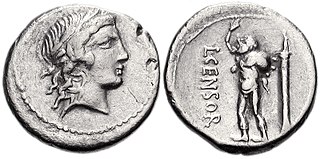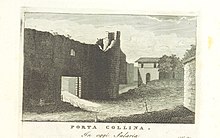Year 82 BC was a year of the pre-Julian Roman calendar. At the time it was known as the Year of the Consulship of Marius and Carbo. The denomination 82 BC for this year has been used since the early medieval period, when the Anno Domini calendar era became the prevalent method in Europe for naming years.

Lucius Cornelius Sulla Felix, commonly known as Sulla, was a Roman general and statesman. He won the first major civil war in Roman history and became the first man of the Republic to seize power through force.
Gnaeus Pompeius Strabo was a Roman general and politician, who served as consul in 89 BC. He is often referred to in English as Pompey Strabo, to distinguish him from his son, the famous Pompey the Great, or from Strabo the geographer.
Gnaeus Papirius Carbo was thrice consul of the Roman Republic in 85, 84, and 82 BC. He was the head of the Marianists after the death of Cinna in 84 and led the resistance to Sulla during the civil war. He was proscribed by Sulla and beheaded by Pompey in Sicily in late 82.
The gens Pontia was a plebeian family at ancient Rome. Few members of this gens rose to prominence in the time of the Republic, but the Pontii flourished under the Empire, eventually attaining the consulship. Pontius Pilatus, as prefect of Judaea, is known for his role in the execution of Jesus.

The Battle of Vercellae or Battle of the Raudine Plain was fought on 30 July 101 BC on a plain near Vercellae in Gallia Cisalpina. A Celto-Germanic confederation under the command of the Cimbric king Boiorix was defeated by a Roman army under the joint command of the consul Gaius Marius and the proconsul Quintus Lutatius Catulus. The battle marked the end of the Germanic threat to the Roman Republic.

Gaius Marius "the Younger" was a Roman republican general and politician who became consul in 82 BC with Gnaeus Papirius Carbo. He was the son of the Gaius Marius who was the victor of the Jugurthine and Cimbric wars. He fought in Sulla's civil war. He committed suicide that same year at Praeneste, after his defeat by Sulla and during the city's capture by Quintus Lucretius Afella.
Lucius Julius Caesar was a Roman statesman and general of the late 2nd and early 1st centuries BC. He was involved in the downfall of the plebeian tribune Lucius Appuleius Saturninus in 100 BC. He was consul of the Roman Republic in 90 BC during the Social War. During the war he commanded several Roman legions against the Italian Allies. He was awarded a Triumph for his victories on the Samnites at Acerrae.
Publius Rutilius Lupus was a consul of the Roman Republic in 90 BC. He led a campaign against the Marsi during the Social War, ultimately resulting in his death at the unsuccessful Battle of the Tolenus River.
Quintus Poppaedius Silo was a leader of the Italian tribe of the Marsi and one of the leaders of the Italian rebels during the Social War against Rome. Poppaedius was called the 'heart and soul' of the rebellion. He was a friend of Marcus Livius Drusus the Younger.
Sulla's civil war was fought between the Roman general Lucius Cornelius Sulla and his opponents, the Cinna-Marius faction, in the years 83–82 BC. The war ended with a decisive battle just outside Rome itself. After the war the victorious Sulla made himself dictator of the Roman Republic.

Marcius Censorinus was a name used by a branch of the plebeian gens Marcia of ancient Rome. The cognomen Censorinus was acquired through Gaius Marcius Rutilus, the first plebeian censor, whose son used it. The gens Marcia claimed descent from both Ancus Marcius, a king of Rome, and symbolically from Marsyas the satyr, who was associated with free speech and political liberty; see further discussion at Prophecy and free speech at Rome. The Marcii Censorini were consistent populares, supporting Marius, Cinna, Julius Caesar, and Antonius.

Lucius Porcius Cato was a Roman general and politician who became consul in 89 BC alongside Gnaeus Pompeius Strabo. He died at the Battle of Fucine Lake, possibly at the hands of Gaius Marius the Younger.

The Battle of Sacriportus also called the Battle of Sacriporto took place in April of 82 BC during Sulla's Second Civil War. The battle pitted the Optimates under the command of Lucius Cornelius Sulla Felix against the Populares forces commanded by Gaius Marius the Younger. The battle resulted in a decisive Optimate victory.
The First Battle of Clusium took place in June of 82 BC during the Roman Republic's Second Civil War. The battle pitted the Optimates under the command of Lucius Cornelius Sulla against the Populares commanded by Gnaeus Papirius Carbo. The battle was indecisive.
Gaius Marcius Censorinus was a late Roman Republican politician and soldier who participated in the first civil war of the Roman Republic, against Sulla.
The Battle of Tridentum took place in a valley just beyond Tridentum in the Autumn of 102 BC. The Germanic Cimbri almost succeeded in overrunning a Roman camp in the middle of the Roman strategical retreat. The Romans were saved by the heroic charge of the men from the Samnite legion which bought the rest of the army enough time to cross the river and escape. Despite some light losses a disaster was averted.
The Second Battle of Cirta, part of the Jugurthine War, was fought in 106 BC between a Numidian-Mauretanian coalition and a Roman army near the Numidian capital of Cirta. The Numidians were led by King Jugurtha, the Mauritanians were led by king Bocchus while the Romans were under the overall command of Gaius Marius who was supported by his quaestor Lucius Cornelius Sulla as cavalry commander. The Romans were victorious routing their opponents and capturing Cirta.
The Battle of Taenum was fought in 90 BC during the Social War. In the battle, Roman forces under the command of Lucius Julius Caesar were defeated by Italian rebel forces commanded by Marius Egnatius.
Pontius Telesinus was the last independent leader of the Italic Samnites before their annexation by the Roman Republic. A fierce patriot, he was one of the rebel commanders in the Social War against Rome, leading the last remnants of the rebellion in southern Italy after the main uprising had already been suppressed. He intervened in the Roman civil wars of the 80s BC in an attempt to improve his and his people's position, but picked the losing side and was killed in 82 BC following the Battle of the Colline Gate against the Roman general Sulla.






